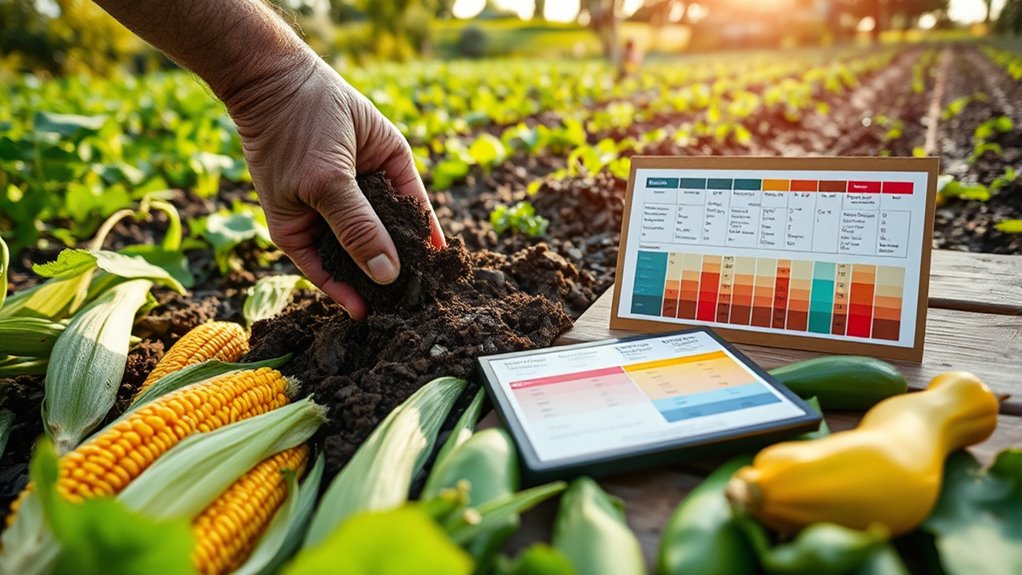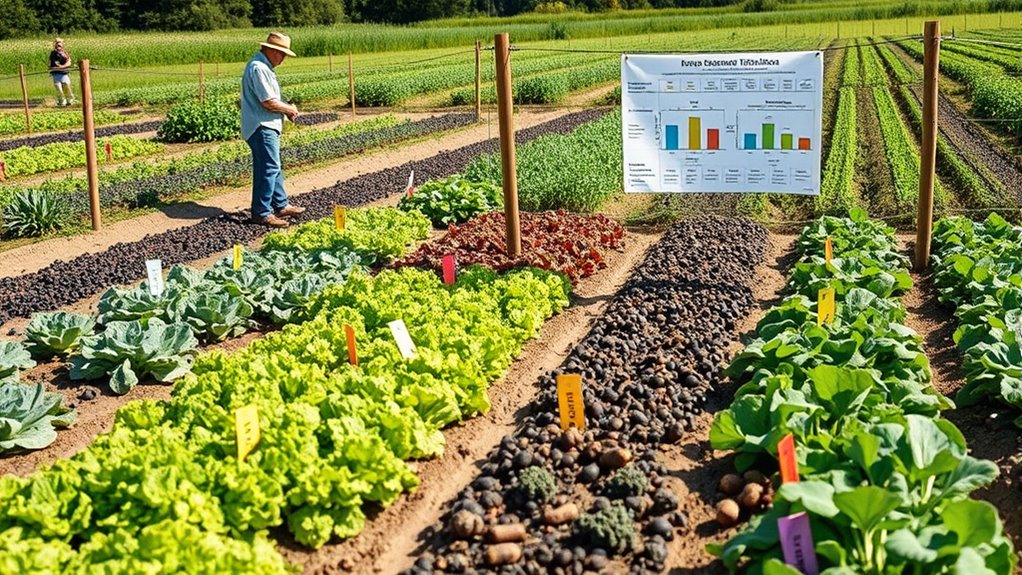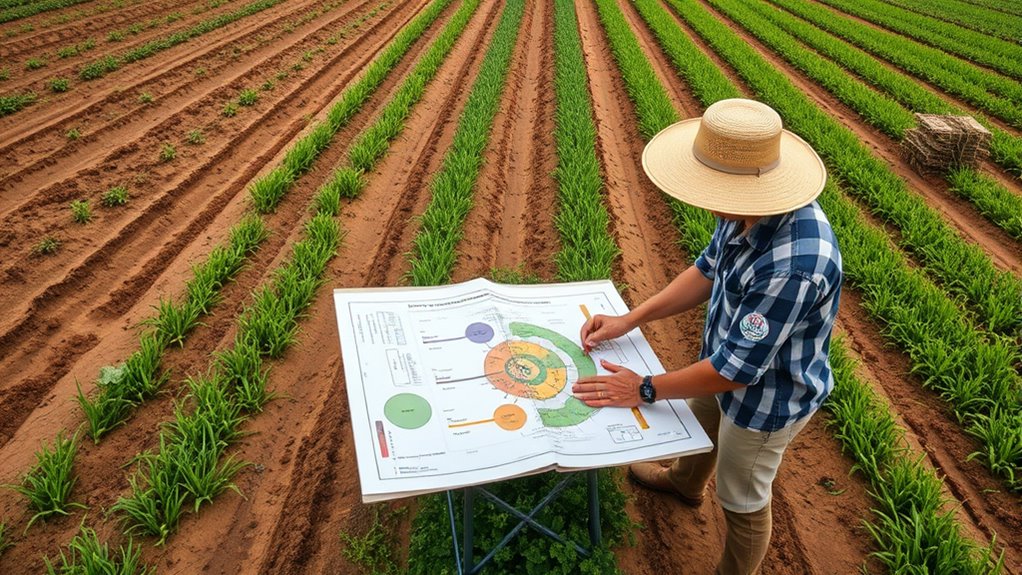To plan a crop rotation that maintains next year’s nutrient balance, start by testing your soil to identify current nutrient levels and pH. Group crops based on their nutrient needs and pest susceptibility, then develop a schedule that incorporates cover crops and green manures to replenish nutrients naturally. Monitor soil health throughout the season and adjust your plan as needed. Keep detailed records for better decisions—if you continue exploring, you’ll learn how to optimize your rotation even further.
Key Takeaways
- Conduct comprehensive soil tests to determine current nutrient levels and pH before planning rotations.
- Rotate crops based on their nutrient needs, such as legumes for nitrogen fixation and heavy feeders for replenishment.
- Incorporate cover crops and green manures to naturally enhance soil nutrients and organic matter.
- Schedule crop sequences to prevent nutrient depletion, aligning planting and harvest times with crop growth stages.
- Monitor soil health regularly and adjust rotation plans based on nutrient status, organic matter, and pest management outcomes.
Assessing Your Soil’s Current Nutrient Status

Before planning your crop rotation, you need to understand your soil’s current nutrient levels. Conduct a soil test to identify deficiencies and excesses. You can buy a testing kit or hire a professional service for accurate results. Take samples from multiple locations in your field to get a representative picture. Label and store your samples properly before sending them to a lab or analyzing them yourself. Pay attention to key nutrients like nitrogen, phosphorus, and potassium, as well as pH levels. Knowing your soil’s baseline helps you determine what amendments or fertilizers are needed to optimize growth. Proper assessment is the foundation for effective crop rotation planning. Additionally, understanding your soil’s nutrient balance can inform more targeted and sustainable fertilization strategies.
Understanding Crop Nutrient Needs and Growth Patterns

Understanding your crops’ nutrient needs helps you optimize growth and yield. You’ll notice that nutrient requirements vary depending on the crop type and growth stage, affecting how you plan your rotation. By observing soil nutrient uptake patterns, you can better match amendments to your crops’ demands at each stage. Incorporating crop rotation strategies can further enhance nutrient balance and reduce soil depletion.
Nutrient Requirements Variability
Crop nutrient needs can vary considerably throughout the growth cycle, influenced by factors such as the plant’s developmental stage, soil conditions, and environmental factors. As your crop progresses, its demand for nutrients like nitrogen, phosphorus, and potassium shifts. During early growth, plants need more nitrogen for leaf development, while later stages require increased phosphorus for root and seed formation. Soil conditions, including moisture levels and pH, also affect nutrient availability, making some nutrients more accessible at certain times. Environmental factors like temperature and rainfall can accelerate or slow nutrient uptake. Recognizing these fluctuations helps you adjust fertilization practices, ensuring your crops receive the right nutrients at the right times. This awareness prevents deficiencies and optimizes growth, ultimately supporting a healthy, productive crop. Additionally, understanding how remote hackathons facilitate collaboration can inspire innovative solutions to agricultural challenges.
Growth Stage Nutrient Demands
As your crop progresses through its growth stages, its nutrient demands change considerably. During early stages, roots need nitrogen for establishment, while in the vegetative phase, they require more phosphorus to support leaf and stem growth. As the crop approaches flowering and fruiting, potassium becomes essential for seed and fruit development. To optimize nutrient use, focus on these key needs: Early-stage growth: Prioritize nitrogen to promote healthy root and shoot development. Vegetative phase: Increase phosphorus to support dense foliage and strong stems. Reproductive stage: Boost potassium intake for flowering, seed setting, and fruit ripening. Additionally, understanding the specific nutrient requirements of your crop can help tailor fertilization strategies for better yields. Understanding these shifts helps you plan crop rotations that meet nutrient demands precisely when needed, reducing waste and improving overall crop health.
Soil Nutrient Uptake Patterns
To enhance nutrient management, you need to recognize how different crops actively absorb nutrients from the soil at various growth stages. Early in the season, many crops take up nitrogen and phosphorus rapidly, supporting initial growth. As they develop, their roots extend deeper, pulling up nutrients like potassium and micronutrients essential for flowering and fruiting. Some crops, such as legumes, fix nitrogen in the soil, reducing the need for external inputs. Understanding these uptake patterns helps you schedule fertilization effectively, preventing nutrient deficiencies or excesses. By matching crop growth stages with their specific nutrient demands, you can improve soil health and ensure peak yields. Monitoring crop development and adjusting nutrient applications accordingly helps you maintain a balanced soil environment throughout the growing season. Recognizing nutrient uptake patterns allows for more precise management of soil fertility.
Grouping Crops by Nutrient Requirements and Pest Susceptibility

Have you ever considered how grouping crops by their nutrient needs and pest vulnerabilities can streamline your crop rotation plan? When you organize crops this way, you can better manage soil health and reduce pest issues. First, identify crops with similar nutrient demands to avoid over- or under-fertilizing soil, which maintains balance and minimizes waste. Second, group plants susceptible to the same pests, enabling you to implement targeted control measures and break pest cycles. Third, rotate crops with different nutrient and pest profiles to prevent depletion of specific nutrients and disrupt pest life cycles. This strategic grouping simplifies decision-making, reduces chemical use, and promotes healthier, more resilient crops. Ultimately, it helps you create a more efficient and sustainable rotation plan.
Developing a Rotation Schedule to Enhance Soil Fertility

Creating an effective rotation schedule involves choosing diverse crops that improve soil health. You should consider the timing and sequence of planting to maximize nutrient renewal and break pest cycles. By carefully planning these aspects, you’ll enhance soil fertility and boost your overall crop yields. Incorporating cover crops into your rotation can further improve soil structure and prevent erosion.
Crop Diversity Strategies
Implementing a well-planned crop rotation schedule is essential for boosting soil fertility and preventing nutrient depletion. To maximize benefits, focus on crop diversity strategies. First, include different plant families to interrupt pest cycles and reduce disease risk. Second, alternate crops with varying nutrient needs—such as legumes, which fix nitrogen, and heavy feeders like corn or tomatoes. Third, diversify planting times and crop types to improve soil structure and organic matter. These practices not only enhance nutrient cycling but also foster beneficial soil microorganisms. By intentionally mixing crops, you create a resilient system that sustains productivity year after year. Incorporating soil health principles into your rotation plan further supports long-term sustainability and productivity. Keep in mind that diversity in your rotation schedule is key to maintaining a healthy, fertile, and productive soil environment.
Timing and Sequencing
Developing an effective crop rotation schedule requires careful timing and sequencing to maximize soil fertility. You should plan to alternate crops based on their nutrient needs and growth patterns. For example, plant legumes after heavy feeders like corn to naturally fix nitrogen in the soil. Timing is vital; ensure that cover crops are sown at the right moments to protect soil during off-season periods. Sequencing crops strategically prevents nutrient depletion and reduces pest and disease buildup. Consider the crop’s root systems and how they interact with the soil, rotating deep-rooted plants with shallow-rooted ones. Additionally, understanding the expiration of crop nutrients can help in planning when to apply fertilizers or organic amendments for optimal soil health. By aligning planting schedules thoughtfully, you create a balanced system that replenishes nutrients, minimizes soil disruption, and boosts overall productivity throughout the year.
Incorporating Cover Crops and Green Manures

Incorporating cover crops and green manures into your crop rotation is a powerful way to enhance soil health and fertility. These plants improve soil structure, increase organic matter, and suppress weeds. To maximize benefits, consider these key steps: 1. Select cover crops suited to your climate and soil needs, such as legumes for nitrogen fixation or grasses for erosion control. 2. Plant them during fall or early spring to protect soil during off-season periods. 3. Incorporate green manures into your rotation by tilling them into the soil before planting your main crops, releasing nutrients and boosting microbial activity. Ensuring proper size and dimensions of the cover crops can also influence their effectiveness in soil improvement.
Timing and Implementation of Crop Transitions

Timing and careful planning are essential to facilitate smooth crop shifts and maintain soil health. You should align planting and harvest dates to prevent gaps or overlaps that can disrupt nutrient cycles. Proper timing ensures your soil remains covered and protected, reducing erosion and nutrient loss. Implement transitions gradually, especially when switching crop families, to minimize pest and disease risks. Additionally, understanding the nutrient balance of your soil can help optimize crop rotation strategies for better yields.
Monitoring Soil Health and Adjusting the Rotation Plan

Regularly monitoring your soil health allows you to make informed adjustments to your crop rotation plan. To do this effectively, focus on key indicators:
Monitoring soil health enables smarter crop rotation adjustments over time.
- Soil Nutrient Levels – Test regularly to identify deficiencies or excesses, helping you choose crops that restore balance.
- Organic Matter Content – Track changes to ensure soil fertility and structure improve over time.
- Soil Biological Activity – Observe earthworm populations and microbial activity to gauge soil vigor.
Documenting and Reviewing the Rotation Strategy for Future Planning

To guarantee your crop rotation remains effective and adaptable, it’s essential to document and review your strategy regularly. Keep detailed records of what you plant each season, including crop types, yields, and soil conditions. This documentation helps identify patterns, successes, and areas needing improvement. Set aside time annually to review your records, evaluating whether your rotation supports nutrient balance and pest management goals. Adjust your plan based on these insights, considering changes in crop performance or soil health. Clear documentation ensures you can track long-term trends and make data-driven decisions. Regular review keeps your rotation strategy aligned with your farm’s evolving needs, helping you optimize productivity and maintain soil vitality for future seasons.
Frequently Asked Questions
How Do Weather Patterns Affect Crop Rotation Planning?
Weather patterns considerably influence your crop rotation planning. If you experience wetter seasons, you might need to choose crops that tolerate excess moisture or adjust planting times to avoid damage. Drier periods require drought-resistant varieties or irrigation strategies. Unpredictable weather can also affect planting and harvest schedules, so staying flexible and monitoring forecasts helps you make timely decisions. Adapting your plan to these patterns ensures healthier crops and better yields.
What Are the Economic Considerations for Crop Choices?
Imagine your farm’s financial health as a delicate garden. You’ll want to choose crops that promise reliable profits, considering market prices and demand. Budget for seed costs, labor, and equipment, ensuring your investments align with expected returns. Diversify to reduce risks and tap into different markets. Balancing short-term gains with long-term sustainability helps you make smart economic decisions, keeping your farm thriving year after year.
How Can I Prevent Soil Erosion During Crop Transitions?
To prevent soil erosion during crop changes, you should plant cover crops like clover or vetch to protect the soil, especially on slopes. You can also use contour farming and maintain crop residues to reduce runoff. Implementing buffer strips along waterways helps trap soil. Additionally, avoid tilling on steep slopes and consider mulching to further stabilize the soil, ensuring it stays in place during changes in cropping patterns.
What Are Common Mistakes in Crop Rotation Planning?
Crop rotation planning can trip you up if you overlook key details. You might plant the same crop too often, depleting soil nutrients faster than they can recover, or ignore the needs of different crops, leading to poor yields. Failing to take into account crop compatibility or neglecting soil health can turn your rotation plan into a house of cards. Be mindful, plan carefully, and diversify to keep your soil healthy and productive.
How Do Pest and Disease Cycles Influence Rotation Timing?
You need to time your crop rotations carefully, considering pest and disease cycles. Pests and diseases often target specific crops, so planting resistant crops or rotating out of susceptible ones can interrupt their life cycles. You should plan rotations to break these cycles, preventing outbreaks. By understanding the timing of pest and disease activity, you can schedule your crops to reduce infestation risks and promote healthier, more productive fields.
Conclusion
By planning your crop rotation thoughtfully, you’ll improve your soil’s health and boost your yields. Have you considered how each change can benefit your land in the long run? With careful monitoring and adjustments, your farm can stay productive and sustainable for years to come. Remember, every rotation is a step toward healthier soil and better crops—so why not start refining your plan today? Your future harvests will thank you.










